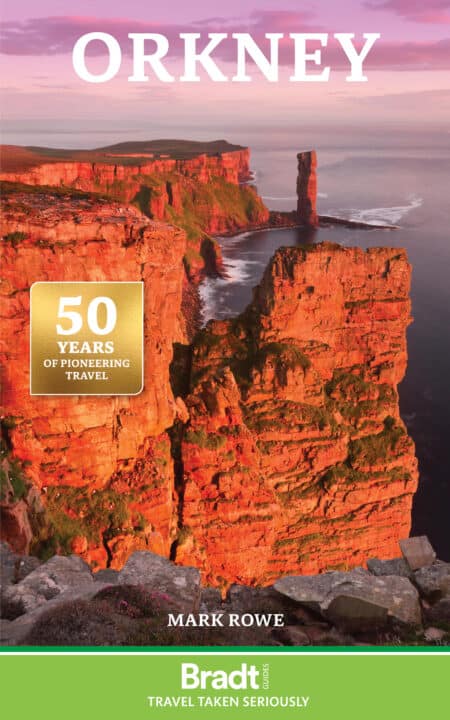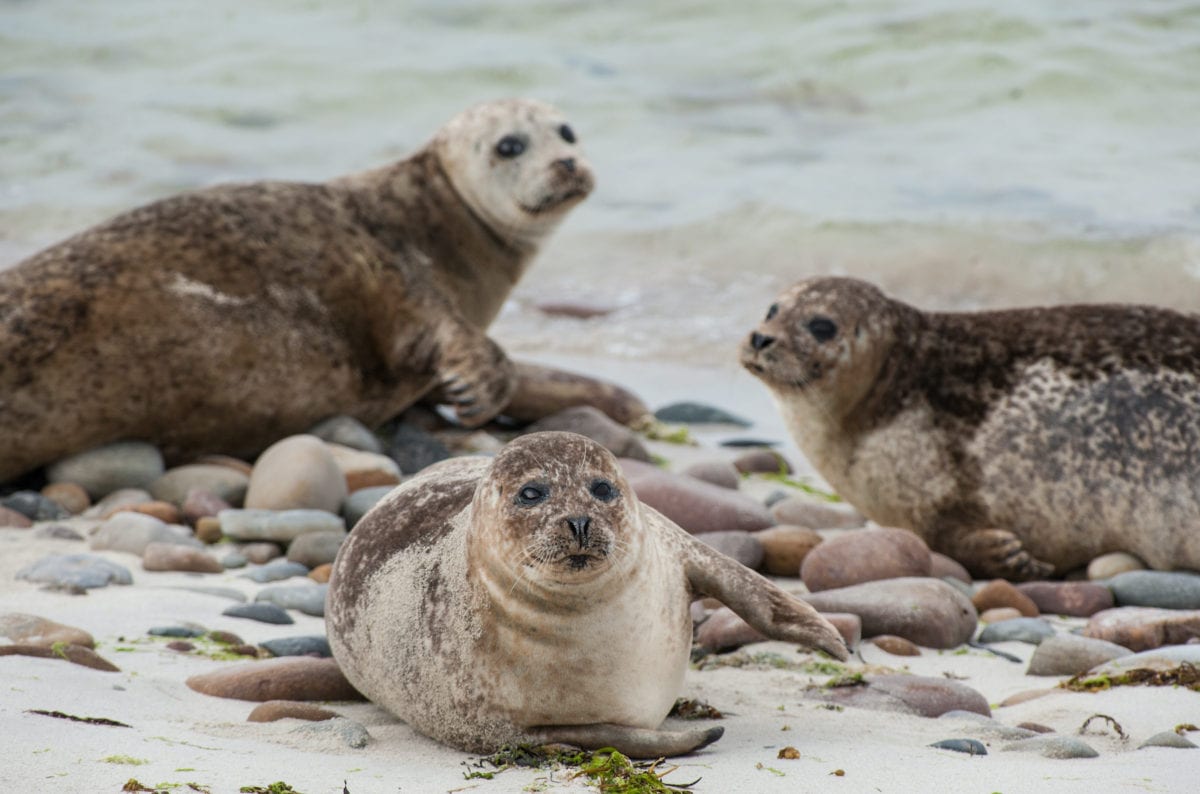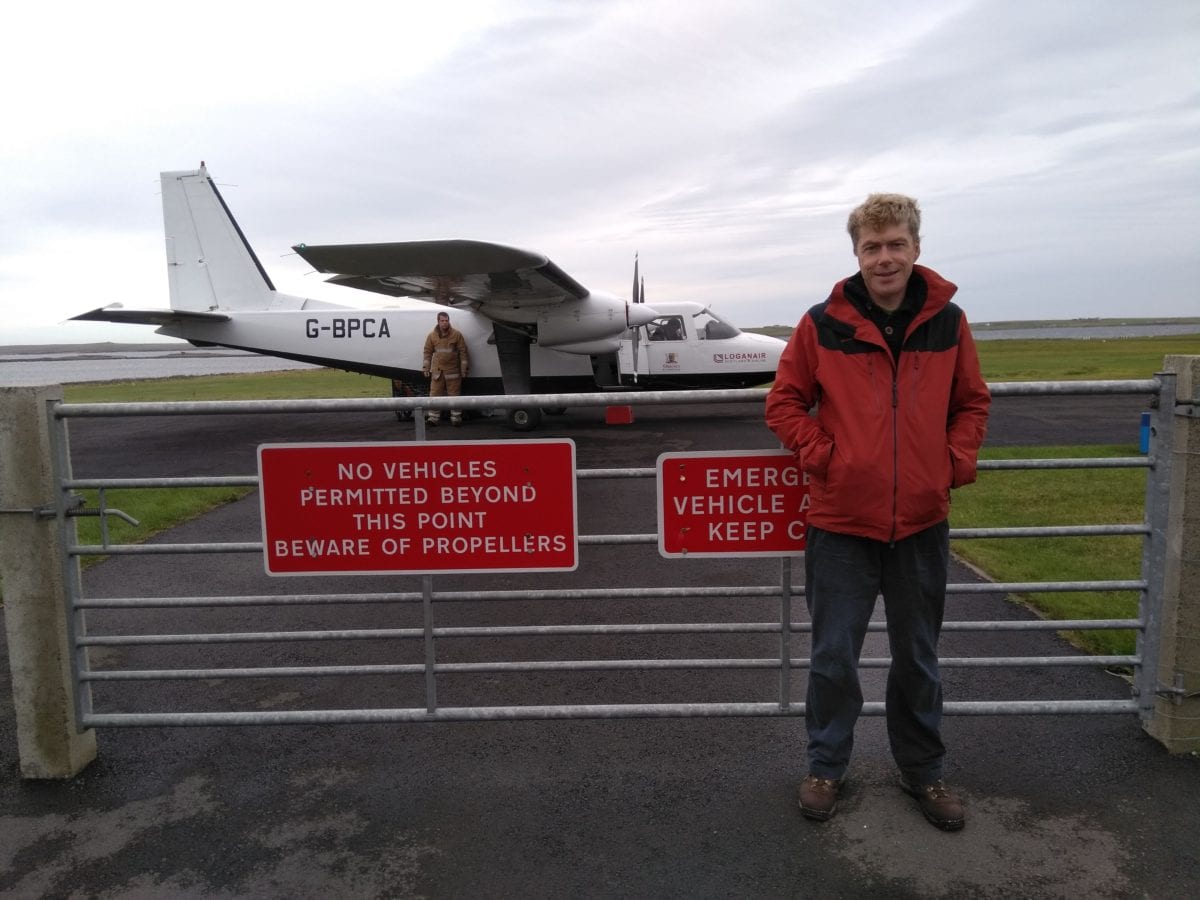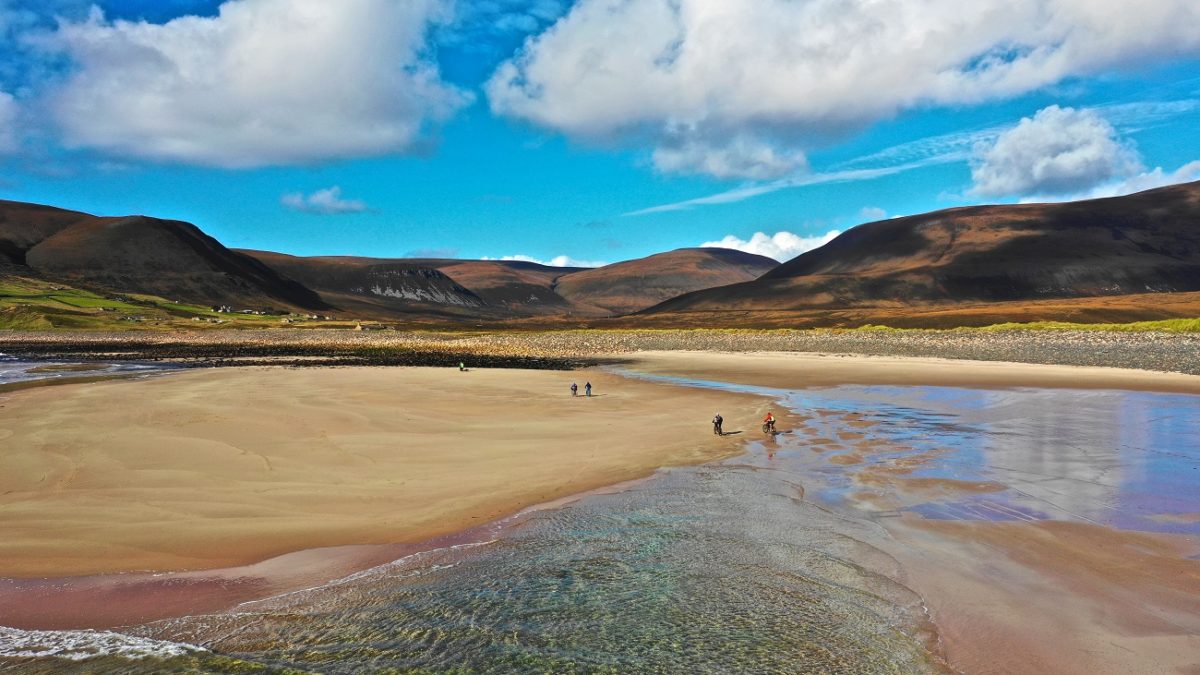Much of Orkney’s appeal is ancient and obvious; but just as much is timeless and will only slowly reveal itself.
Mark Rowe, author of Orkney: the Bradt Guide
Located eight miles to the north of the Scotland mainland, Orkney everything a visitor could wish for in a holiday. This archipelago of 70 islands (19 inhabited) is justifiably best known for its archaeology: the Neolithic village of Skara Brae, the equally ancient burial chamber of Maeshowe and the standing stones of Stenness.
These are just the headline acts, though, as Stone Age burial chambers and houses, along with Bronze Age and Viking sites, are found right across the island chain.
Whether you arrive by sea or air, you’ll discover that this is a travel destination offering an extraordinary sense of space and of getting ‘away from it all’. Its landscape of sweeping hills, gorgeous beaches, high cliffs and secluded valleys offer myriad walking and cycling routes, as well as some of the UK’s best wildlife opportunities.
During a trip to this magical archipelago, you are sure to see harbour and grey seals lazing on beaches, majestic gannets dive bombing the waters of Scapa Flow and clockwork-toy puffins clinging to cliff edges – and that’s just the beginning.
It’s not all about the great outdoors, though. Each island boasts its own distinct culture, and life generally rolls at a much slower pace than on the British mainland. The islands’ burgeoning food and drink scene is surprisingly stellar, and in every settlements you will find excellent eateries serving produce fresh from the islands’ farms and waters, along with locally brewed beers, craft gins and the world’s most northerly whiskies.
For more information, check out our guide to Orkney
Food and drink in Orkney
Food
From local beef to salmon, shellfish, oatcakes, cheese and lamb, food in Orkney has undergone a revolution over the past 20 years. Drawing heavily on the sea and fertile soils, Orkney was promoting local and ‘slow’ food long before the concepts became fashionable in metropolitan areas of the UK. All local food has a kitemark, ‘A taste of Orkney’, and it is unusual to come across any restaurant or local shop that does not steadfastly emphasise its Orcadian credentials. Foodies will enjoy indulging in the excellent website orkneyfoodanddrink.com, which features a comprehensive listing of producers and retailers. An astonishing number of local food outlets and family producers, from bakers to butchers, go back more than 50 years – and some more than 100 years.
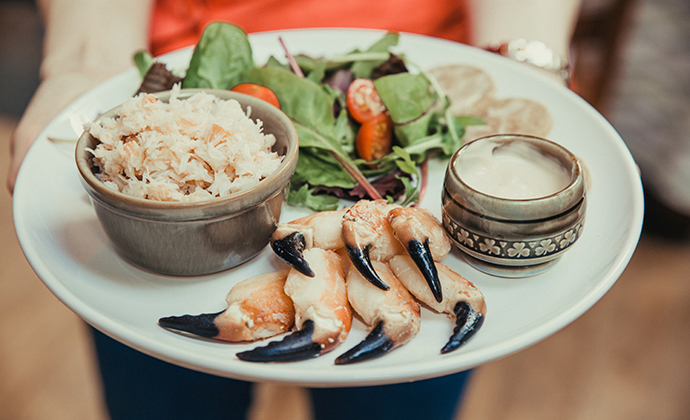
Fish and shellfish are ubiquitous and delicious. Look out for fresh shellfish from the Stromness-based Orkney Fishermen’s Society: scallops, brown crab (all edible crabs are known locally as partans) and lobster, along with langoustines from Scapa Flow plus line-caught mackerel and other fish from Westray. Cullen skink, a traditional Scottish dish of smoked fish, cream and potatoes, becomes a high art in Orkney. Another classic Orcadian dish is clapshot – potatoes and turnips cooked and mashed together, generally served with sausages or salmon.
You will find Orkney beef on just about every menu and can also buy it from venerable producers such as E Flett in Stromness and Donaldsons of Orkney in Kirkwall. Almost as common is North Ronaldsay lamb, possibly Orkney’s best-known food export. The lamb is prized for its salty taste, a flavour that results from the fact the sheep enjoy a diet of seaweed.
Dairy produce is also of high quality. The only Orkney cheese you usually see in supermarkets on the UK mainland is an orange cheddar. This is a shame given that several excellent local cheesemakers are based on the islands. Varieties include crumbly cheeses originally produced by Hilda Seator at Grimbister Farm Cheese (a business now run by Hilda’s daughter-in-law, Ann); her flavours include chive, garlic, whisky and walnut. The Orcadian penchant for combining refinement with lipsmacking, calorie-laden dishes probably reaches its apogee in the form of Grimbister cheese served in deep-fried wedges, which you will often encounter in restaurants. Of similarly high quality are the smoked cheddars produced by the Island Smokery in Stromness, which are flavoured with whisky or apricot or black pepper as well as green tomato chutney. You should look out for Westray Wife, a tangy cheese produced by Wilsons of Westray.
Drink
Island whisky is considered a strength, particularly the liquid distilled at Highland Park, the world’s most northerly distillery. Its rival, Scapa, lies barely a mile south. Good and varied, Orkney beer was riding the craft wave some time before it became fashionable in the rest of the UK. Two local breweries will keep real-ale fans content. The players here are Swannay Brewery whose Scapa Special and IPA are perennially popular; and Orkney Brewery, whose range includes the signature Dark Island brew and the lighter, citrus-flavoured Corncrake ale. Both breweries are located on the west of the Mainland; you will see their beers sold everywhere and most pubs will have them on draft.
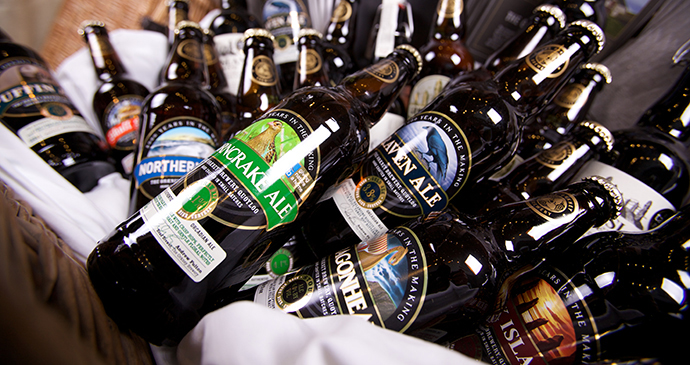
In recent years gin distilleries have popped up: Kirkjuvagr Orkney Gin on the Kirkwall waterfront; the Orkney Gin Company on Burray; and the Deerness Distillery in the southeast of the Mainland. All three have tapped into the craft gin movement, offering everything from Seville orange- to cinnamon-flavoured liver ticklers.
Health and safety in Orkney
Health
Tap water is drinkable across the islands. Your chances of getting food poisoning are the same as anywhere in the UK, ie: pretty low. Orkney is fairly low-lying, so generally it is not advisable to drink water from streams as they may only be rarely above human habitation. That said, you can always gather the water and drop a chlorine tablet into your bottle, as you might elsewhere in the world.
Midges certainly flex their muscles in Orkney, though there is nothing remotely approaching the formidable squadrons found in the Highlands and on Skye, or even on the Outer Hebrides. The most vulnerable to the beasties are those who fish in lochs on a calm day. Of more concern should be horseflies, known locally as cleggs, whose bites can cause horrendous swellings. Be mindful also of sheep ticks, or kebs, should you rummage around in sheep wool at factories or farms. Your chances of contracting orf are low but your GP may be slightly excited and intrigued should you return with the disease, which manifests itself with a mild fever and scabby, puss-filled lesions.
One nasty disease that ticks are increasingly transmitting is Lyme, a bacterial infection often manifested by a circular rash and/or flu-like symptoms and muscle and joint pain. The NHS website provides good information on the disease.
Safety
Orkney is an extremely safe place to visit and you are unlikely to have any kind of negative experience on the islands. Crime is extremely low (though the theft of Stations of the Cross from the Italian Chapel in 2014 stunned everyone.
The circumstances in which you should be mindful of risk emerge when you explore the great outdoors. When walking, you should certainly be wary of cattle, which will not be as well versed in the rights of open access as you might be. Avoid getting between a calf and its mother and be particularly cautious in May when most cattle are finally let out of their barns after being cooped up for the best part of eight months. Every year there is a handful of incidents involving cattle trampling people (usually farmers). Use your judgement and certainly keep dogs on a lead when in any field with livestock. Rusty and sharp-edged farm gates are ubiquitous and an easy way to scratch yourself and introduce infection.
Only on Hoy, with its high hills and deep valleys, is the combination of remoteness and bad weather a safety consideration when walking. Always be mindful of cliffs, which can be remarkably adjacent to coastal footpaths in a way you rarely see anywhere in, say, Devon and Cornwall. Another landscape feature that Orkney possesses is the ominous-sounding gloup, a large hole near cliffs that drops to the sea. These are very rarely fenced off. Needless to say, avoid walking in fog in their proximity.
Always ask locally which beaches are safe for swimming. The same goes for quicksand, which is rare but can come and go depending on how much water is carried by a burn to the beach.
Travel and visas in Orkney
Visas
Orkney is part of the UK, so entry requirements only apply to the port at which you arrive in the UK: you can freely travel between the UK mainland and Orkney. After the UK leaves the European Union, documentation requirements for EU citizens may change. Check before travelling. Whatever happens, one principle will apply: once in the UK, you are freely able to travel to Orkney.
Getting there and away
For somewhere so far north, Orkney is remarkably accessible from the British mainland. Most people travel by car and ferry; train and ferry is a viable option, as is flying (albeit more expensive).
By sea
Orkney is served by three car-ferry routes and a seasonal foot-passenger ferry.
The most popular crossing is the Scrabster–Stromness service on the MV Hamnavoe, operated by NorthLink Ferries, which runs up to three times a day between Scrabster pier, 1.5 miles west of Thurso on the north coast of the Scottish mainland, and Stromness on the Mainland. The other major car-ferry route to Orkney runs from Gill’s Bay, 5 miles west of John O’Groats, to St Margaret’s Hope on South Ronaldsay. The service is managed by Pentland Ferries and runs up to four services per day on a catamaran. At just 1 hour this is the quickest car crossing to the islands.You can also travel the Aberdeen–Kirkwall route with the NorthLink Ferries service that sails between Aberdeen, Orkney and Shetland.
Between May and September, a seasonal foot-passenger ferry operates two to three times a day from John O’Groats to Burwick on South Ronaldsay. The journey time is 40 minutes.
By air
Flights from the UK mainland go only to Kirkwall and are provided solely by Loganair. The airline handles flights from Glasgow, Edinburgh, Aberdeen, Inverness and Manchester as well as Stornoway (Hebrides) and Lerwick (Shetland).
If flying from outside Scotland, either from the UK or internationally, you will need to transit through a Scottish airport (the sole exception is Loganair’s Manchester–Kirkwall flight) to reach Orkney.
Getting around
Even how you explore the outer islands is likely to prove a memorable part of your visit. In practice, most people will bring a car simply to cover more ground more quickly; a private vehicle is comfortably the most convenient means of getting from A to B. But even if you do drive, consider complementing your travel with buses or cycling; ferries and air travel also offer unforgettable experiences. Many visitors make the mistake of travelling to the Outer Isles as foot passengers. With the exceptions of Papa Westray and North Ronaldsay, this will severely limit what you can see and do on the islands as bus services are all but non-existent, most sites are located away from the ports and very few have anything that resembles a tourist office. The reality is that most of the outer islands feel too big to take a car to but are just too small to explore on foot. Cycling is a good compromise.
By car
Orkney’s roads are almost universally good. A comprehensive network of A roads with one lane in each direction reaches most parts of the Mainland and continuesall the way down South Ronaldsay via the Churchill Barriers. Be aware that thanks to the many bends, and locals zooming up behind you, motoring on the Mainland requires a good deal of concentration, so whoever sits behind the wheel may miss out on the scenery. Some roads on the Mainland and the majority on the islands are single-track roads with passing places. The latter concept can throw you if you’re not familiar with it. The easiest thing is just to have a default attitude of yielding to let others come past. Smiling and waving at fellow motorists makes things all the smoother.
By bus
Bus services on the Mainland (and across the Churchill Barriers to South Ronaldsay) are good but rare to non-existent on the Outer Isles. On the Mainland, all major sites can be reached by bus and a good service links Kirkwall and Stromness. Try and get hold of Travel Times, an excellent free booklet listing summer timetables for all bus and ferry services. You should find it at the Visit Scotland information centre in Kirkwall and the adjacent Kirkwall Travel Centre. The same information is online at orkney.gov.uk/transport, though picking your way through the clicks and scrolls is a little laborious.
By ferry
All inter-island ferries are operated by the council-owned Orkney Ferries. Fares are usually paid on board. Orkney Ferries also offers an Island Explorer pass, which offers ten consecutive days of unlimited travel for foot passengers – note that bicycles are carried for free.
The South Isles of Hoy, Graemsay and Flotta can all be reached by ferry. Lyness (halfway down the east coast of Hoy) and Flotta are served by a vehicle ferry from Houton, 8 miles southwest of Kirkwall. A separate foot-passenger service runs between Stromness, Graemsay and Moaness in North Hoy.
The majority of the North Isles (Shapinsay, Stronsay, Eday, Sanday, Westray, Papa Westray and North Ronaldsay) are served from Kirkwall. The exception is Rousay, which is reached from Tingwall, 12 miles west of Kirkwall; this route also takes in Egilsay and Wyre. All these services take vehicles. A separate foot-passenger ferry connects Westray and Papa Westray. You’ll sometimes hear people on the Mainland describe – tongue in cheek – the islet of Galt Skerry, just to the north of Shapinsay (the island closest to Kirkwall), as the edge of the civilised world: beyond lies the unknown, Orkney’s Ultima Thule. Journey times vary from 25 minutes to Shapinsay to 90 minutes for direct sailings to most other islands.
By air
You can fly from Kirkwall to six of the North Isles, with regular services to Stronsay, Westray, Papa Westray, Sanday and North Ronaldsay, and less frequent flights to Eday. All flights to the outer islands are operated by Loganair. Some flights are direct, others call in at one or more other islands. Note that it is not possible to check through to these islands from flights originating outside Orkney: you need to leave adequate time to reclaim your bags at Kirkwall and check in again. The Westray–Papa Westray route, famously the world’s shortest scheduled flight at 1 minute, is not the only flight that you can blink and miss: journey times are usually 8–15 minutes in duration.
When to visit Orkney
Climate
Orkney enjoys a hyper-oceanic climate, which means that it is cool and wet all year around, with temperatures averaging 5°C in winter (but sometimes as low as –5°C) and 15°C in summer (with occasional highs in the mid-20s°C). This is largely due to the Gulf Stream, the current of equatorial warm water that travels northeast across the Atlantic Ocean then around the British Isles. North Ronaldsay for example is a good 5°C warmer than anywhere else on the same latitude, such as Newfoundland or Kamchatka in the far east of Russia. Good and bad weather can happen at any time of year. You may get a 60mph gale fly through in June; as a counterpoint, winter is frequently alleviated by a week here or there of glorious weather. The period from October to January sees the most rain and, for somewhere so far north, Orkney can produce solid tropical downpours that ping off your waterproofs like buckshot.
That Orkney ferries run their winter timetable from the end of September to the start of May tells you much of what you need to know about prevailing weather trends. From November through to end February nights are long. The shortest day sees the sun rise at 09.04 and set at 15.15.
March and April often bring the North Sea haar, a chilly sea mist, to the northern isles. This can sit all day or suddenly evaporate to reveal bright blue skies. May is historically the sunniest month. The pay-off for the long winter is the extended hours of summer light, with the sun rising on 21 June well before 04.00 and setting at 22.30 – though a half-light persists beyond midnight, particularly on the most northerly islands of Westray and North Ronaldsay.
Orkney has plenty of wind: the average wind speed across the islands is a remarkable 38mph; the highest recorded speed was 125mph on 31 January 1953. As with the rest of the UK, the first storms tend to arrive in late September. Unlike the rest of the country, Orkney generally just takes them in its stride.
When to visit
Orkney is a year-round destination with every season offering reasons to come here. Regardless of date, the natural world always has something for everyone – as does the manmade environment, with festivals, dances and events held throughout the calendar. And it’s best not to plan around the expected weather – clement and inclement conditions can transpire at any time of year. A week in July can be damp, cold and soggy; conversely, November may bring clear skies and magical sunsets.
For good reason spring and summer are by far the most popular times to visit. By the start of May, the avian race to breed is on and the sky is full of birdlife; wildflowers are emerging in all their glory along clifftops, in fields and even on roadside verges. The weather warms up and, statistically, this is the driest time of year. High summer brings endlessly long days where, although the sun officially drops behind the horizon for 5 hours or so, there is a magical half-light that hangs on into the small hours. Summer months are also good if you are keen on archaeology, as this is the time when many researchers and students are liberated from university lecture rooms and get a chance to dig up Orkney’s landscape. Regular excavations continue every summer at the Ness of Brodgar, on Rousay and Westray – but you may see similar signs of activity anywhere.
By September, autumn is already firmly in place. The modest woodlands sprinkled across Orkney are turning orange and brown, while long skeins of geese cut through the skies as they retreat from the oncoming Arctic winter. The secret is slowly getting out that late autumn to early spring is as good a time as any to visit Orkney. Yes, the days are shorter and deepest February can sometimes be grim, but wandering around windswept islands and burial mounds at dusk on such days offers an unrivalled opportunity to embrace your inner Neolithic ancestry. Autumn sees an increase in storms: an Orkney hoolie (a Scottish term for a gale or storm), with 36 hours of winds that never dip below 70mph, is something to behold – but there again a period of high pressure may allow you to enjoy several successive stunningly clear, still days. Off peak, it is likely you will have the guide to Maeshowe to yourself; in July you will share the minibus that takes you to the site with 30 others. And on the wild side, October is prime pupping time for the colonies of grey seals.
Winter brings a sporting chance of catching the Merrie Dancers, or northern lights – you are more than far enough north to spot them. Stand outside on a clear December night and it can feel like you are in the middle of a planetarium. On the Mainland in particular shops, most B&Bs and hotels and major attractions stay open all year, allowing you to enjoy them without the crowds of high season. As David Loutit, owner of The Creel guesthouse in South Ronaldsay, puts it: ‘Orkney is completely different in winter. Yes, it’s a little colder, it’s a little windier, but the storms are fantastic.’
Where to stay in Orkney
For information about accommodation, see our list of the best places to stay in Orkney.
What to see and do in Orkney
Cata Sand
A vast tidal sandy bay stretching for 2 miles, Cata Sand is flanked by 30ft-high dunes of glittering white sand that nature has sculpted into extremely fetching triangular shapes. One after another, the dunes dance their way down the eastern flanks of the bay among a collage of spits, bars and flats. The interchange of light and water here is utterly astonishing. When the tide ebbs, it is as though the proverbial plug has been pulled, and the converse is true as well; the waterless bay can suddenly flood with a sheet of water so thin at first that the aquamarine colours resemble a photo montage of the Caribbean.
Italian Chapel
Less than half a mile long and scarcely any wider, Lamb Holm is a mere pebble at the foot of the mighty Mainland, yet it sees almost as many visitors as anywhere else on Orkney. This is, of course, because it is home to the ornate Italian Chapel, built by (Italian) prisoners of war in the early 1940s. La Bella Cappella Italiana, to give the chapel its full name, is perched on a windswept mound overlooking Holm Sound. A visit to this minuscule building, which resonates with human emotion, is justifiably popular.
The chapel was built at Camp 60 in 1943–44 by covering two Nissen huts on the outside with concrete and coating them with bituminous felt. The artwork was completed by Domenico Chiocchetti; the wrought-iron work was undertaken by Giuseppe Palumbi, a trained blacksmith. They were joined by other felicitously named helpers – Bruttapasta, a cement worker, and Primavera, an electrician. All four were among 1,300 Italian POWs brought to Orkney to work on the Churchill Barriers. Outside the front door is a wooden carving of Christ on the Cross, gifted by the city of Moena, Chiocchetti’s home town. Every so often, an expert delicately restores the blemishes that appear; most recently, in 2015, this was completed by Antonella Papa, an artist who has worked on the Sistine Chapel. Chiocchetti began by hiding the interior of the corrugated iron of the hut behind a façade of plasterboard which he then painted with trompe l’oeil brickwork and carved stone to give the impression of tiles and stonework friezes. An altar, altar rail and holy-water stoop were moulded in cement by Bruttapasta.
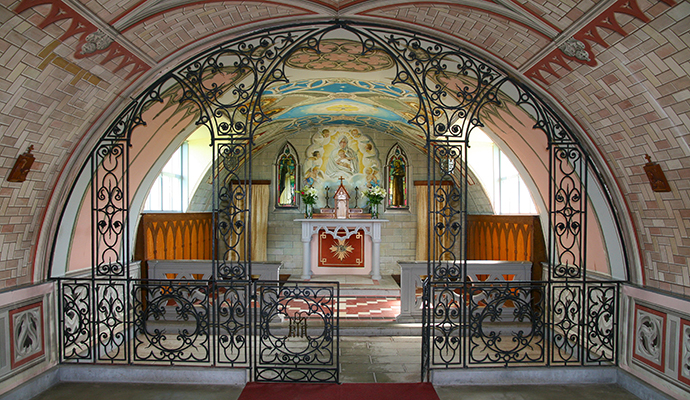
A ceiling passage leads to the altar where an image of Madonna and Child, painted by Chiocchetti, gazes down at you. The infant Jesus holds an olive branch while an angel holds a shield from Chiocchetti’s home town, depicting a ship passing from a dark storm of war to the light of peace. The painting was inspired by the same image by the artist Nicole Barabino, on a card given to Chiocchetti by his mother. On either side are paintings of St Catherine of Siena and St Francis of Assisi. Lanterns were made from bully-beef tins, and both a bell and candlesticks were taken from the rods of a stair on an old blockship.
Bruno Volpi, another POW at Camp 60, once explained why so many POWs invested time and emotion in the project: ‘it was the wish to show, first oneself and then the world, that in spite of being trapped in a barbed-wire camp, with one’s spirit physically and morally deprived of many things, one could still find something inside that could be set free’.
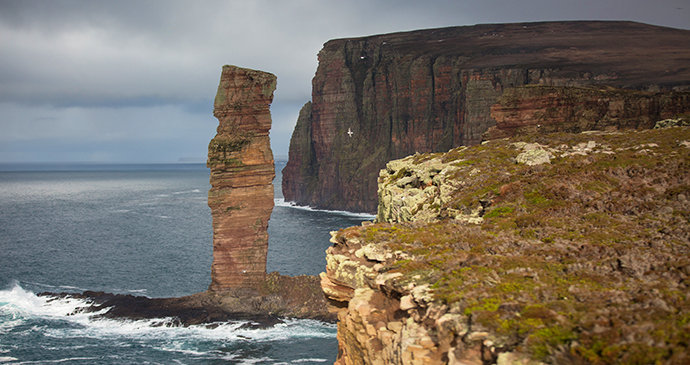
Old Man of Hoy
Most people who reach Rackwick are bent on a nose-tonose view of the iconic sandstone column that features in every tourist brochure to both Orkney and Scotland. Standing 450ft (137m) high, this is Europe’s tallest sea stack. Buffeted by ever-turbulent waves at its base, it makes for an absorbing and thrilling spectacle. To see it, you have to walk to it.
Rising from a pedestal of dark basalt lava, the Old Man of Hoy comprises fragile Old Red Sandstone intermingled with layers of flagstone that create distinctive slab-like ridges upon which nesting fulmars look tiny. Geologists reckon that the Old Man is a relatively recent creation: maps from 1600 and 1750 only portray a headland here.
Even more recently, he had two ‘legs’ that created a natural arch before one ‘limb’ was swept away by a storm in the early 19th century. This same combination of ocean and geology means that sooner rather than later the Old Man of Hoy will tumble into the sea. The name is – possibly – one of the few Gaelic names in Orkney, perhaps originating from ‘allt’ (‘cliff’) and ‘maen’ (‘stone’).
The summit was first conquered in 1966 by Sir Chris Bonington, Tom Patey and Rusty Baillie. At the top the trio built a cairn and lit a fire; Patey later reported that ‘in our enthusiasm, it got out of hand and only collective action saved us from the inconvenience of a fast abseil down melting nylon’.
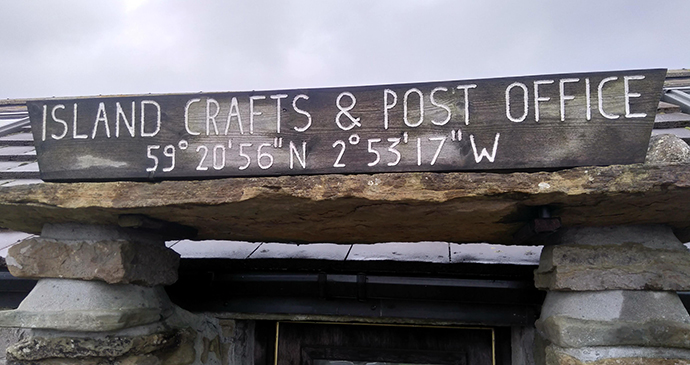
Papa Westray
Known as ‘Papay’ to its inhabitants and everyone else on Orkney, Papa Westray is one of those resonant names that brings to mind a far-flung location on the periphery of everyday life. Perched at the north of the Orkney archipelago, 20 miles north of Kirkwall, and lying more or less on the same latitude as Stavanger in Norway, Papay certainly ticks the geographical box for remoteness. Gaze north from the appropriately named North Hill and you’re looking at water unbroken until you reach the Arctic. This is an island where mains electricity only arrived in 1980. There is, though, a certain irony in the fact that an island so cherished for being ‘away from it all’ is so well connected to the outside world, with its prime attraction being the blink-and-you-miss-it flight from neighbouring Westray.
Papay is tiny, just 4 miles long by a mile wide, yet there is plenty to keep you here for considerably longer than it takes the aircraft to fly here. The island has important Neolithic sites, viewed in the extraordinary light that you only really experience on small islands: fine, delicate sky blues that blur with sandy beaches and dark green moorlands. All this is framed and infilled by a fabulously indented coastline of cliffs, bays and farmland.
Ring of Brodgar
Set on slightly raised ground, the Ring of Brodgar Stone Circle and Henge features 36 monoliths (originally perhaps 60), 27 of which still stand today (the remainder lie prone or in fragments). The monoliths vary considerably in size: some are oblong, others thin and slender, still more resemble stumpy incisors. Scottish geologist Hugh Miller described them as ‘an assemblage of ancient druids’. All are made of old red sandstone and range from 7ft to 15ft in height. Although they can look damaged or deliberately cut at an angle, this is actually a natural feature resulting from fracturing or erosion (you can see this for yourself at spots such as the cliffs at Yesnaby). The stones form a near-perfect circle 340ft in diameter. The stones are surrounded by a rock-cut ditch, which was once 7ft deep and 21ft wide. While the site is often described as a henge, this is contested by some archaeologists on the basis that henges usually have an external bank, which is absent in the case of Brodgar.
Skara Brae
Many much-heralded sites can be a let down when you finally visit them: not so Skara Brae, which is managed by Historic Environment Scotland. Britain’s earliest known Neolithic village, dating back more than 5,000 years, Skara Brae is simply haunting. A visit comprises a walk through an excellent interpretation centre, a reconstruction of one of the Neolithic houses, and a short stroll to the village itself, perched hard above the magnificent setting of the Bay o’ Skaill, with headlands pulling away to the north and south.
Occupied from 3100–2500BC, Skara Brae predates the Pyramids of Giza by 600 years and Stonehenge by 1,000 years. The site re-emerged during a storm in 1850, some 4,400 years after it had been abandoned. What you see today represents two distinct phases of occupation. Houses 6, 9 and 10 probably date to the earliest community, around 3500BC, which survived for a few hundred years. The site was then abandoned for several hundred years before being occupied again from 2900–2500BC.
In all, there are eight houses of similar design, with a single room entered from a roofed passageway that, like a street, linked each dwelling. Each house had the same internal layout, with stone beds to the side, a central hearth and a dresser opposite the entrance. While this uniformity brings to mind a modern building development of identikit houses, it also provides a possible insight into the psychology of those who built them and lived there: harmony may well have been essential to the functioning of the village. This sense is reinforced by the fact that no single house is obviously larger or more ostentatious than any other: this was a community where, most likely, people treated each other more or less as equals.
Skara Brae probably supported 50–100 people; each house was most likely home to a single family. The exception is house 8, which is thought to have been a workshop for making stone tools and pottery. The best-preserved and most substantial dwelling is house 1, where you can peer down and examine the central hearth, beds and dressers of stone slabs as well as stone tanks embedded in the sand that were used for preparing fish bait. Occupants used bracken and deer skins to make their ‘furniture’ comfortable. For food, they hunted deer, gathered berries and reared pigs, sheep and cattle. Stone food boxes were lined with clay to act as refrigeration. Whalebone arches were used to secure doors.
Stromness
Orkney’s second-largest and most attractive settlement, Stromness is a stone-built port hunkered down in a sheltered harbour. At its heart is a tight-knit huddle of houses, quaysides and slipways all but embedded in the granite ridge of Brinkies Brae, which towers above them. An 18th-century imprint underpins the town – apparent in the three-storey terraced houses that are topped with triangular gable ends of crow-step design. At ground level, these houses open hard on to the street or abut narrow alleys that face stone waterside piers, jetties and nousts. Overall, the town, which has just over 2,000 residents, has a pleasingly weathered yet warm appearance.
Stromness translates from Old Norse as ‘headland in the tidal stream’ and you can almost see the ghosts of young men preparing to sail on whaling adventures to the Arctic or ready for service with the Hudson’s Bay Company. That sense of yesteryear is augmented by the smell of peat- and wood-burning stoves and the ever-present sloshing of the sea.
Stromness is curtailed to the east by the harbour of Hamnavoe, or Haven Bay, which, together with the adjacent islands of Outer and Inner Holm, has provided shelter and refuge from weather and attack since Viking times. The town has a different vibe to Kirkwall – and it is a vibe, for this is an artistic settlement of some stature. In the town’s early days, you clearly had to have something about you to both survive and thrive here, and that spirit is still apparent. Consequently, Stromness manages to maintain the feel of a pioneer town.
Vat of Kirbuster
Stronsay’s premier attraction is the dramatic arch and gloup (or blowhole) known as the Vat of Kirbuster. Located in the southeast corner of the island, this natural arch represents a shockingly elemental slice of geology and deserves its place in Orkney’s sizeable pantheon of startling clifftop architecture. To reach the Vat, you must drive or cycle to Kirbuster (the destination is well signposted) some 3 miles from Whitehall. Park in the lay-by just south of Kirbuster Farm. Walk along the narrow path through the field to the coast and turn right; within 10 minutes you’ll be at the Vat.
You know you’ve reached the right place as the cliff edge suddenly curves deep inland in a broad arc and – just – completes a full circle. The result is the creation of a gloup measuring 150ft in diameter and dropping for 60ft to the sea. On its seaward side the gloup has partially collapsed, allowing the sea to rush in. (This may be the origin of the name, as ‘vat’ is Old Norse for water or lake; that said, ‘kirbuster’ translates as ‘church farmstead’ and there is a farm but no church nearby.) The rim above the collapsed cliff is supported by a single ridge of sandstone, which functions as a natural lintel or capstone, keeping the structure from collapse. A couple of fences and boardwalks allow you to walk around the Vat in relative safety. Exposed ridges and rocks add to the drama, as do the huge fronds of tussock grass that drape down the Vat’s sides, resembling a frozen green waterfall. Just as impressive is the birdlife – fulmars and ravens – that tend to nest on these vertical grasses. You can return the same way or consider a circular walk that continues via Burgh Head and Lamb Head.
Related books
For more information, see our guide to Orkney:
Related articles
From greater skuas to grey seals, Orkney boasts a wealth of fantastic wildlife-watching opportunities.
Join Mark Rowe on an unique island-hopping adventure in Orkney.
These Scottish island chains are home to some of the most spectacular sands in the UK.
